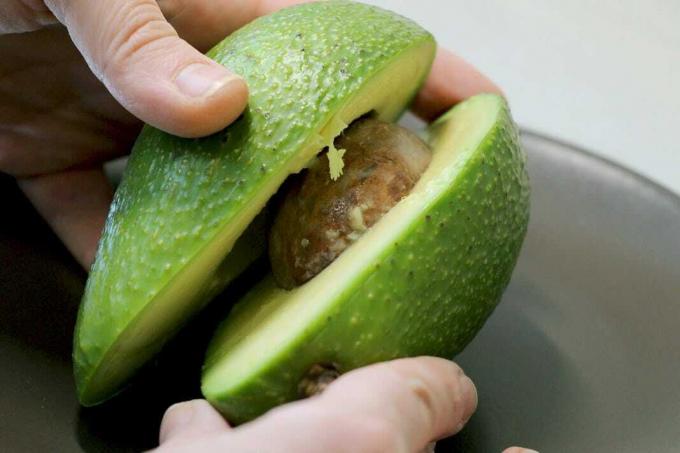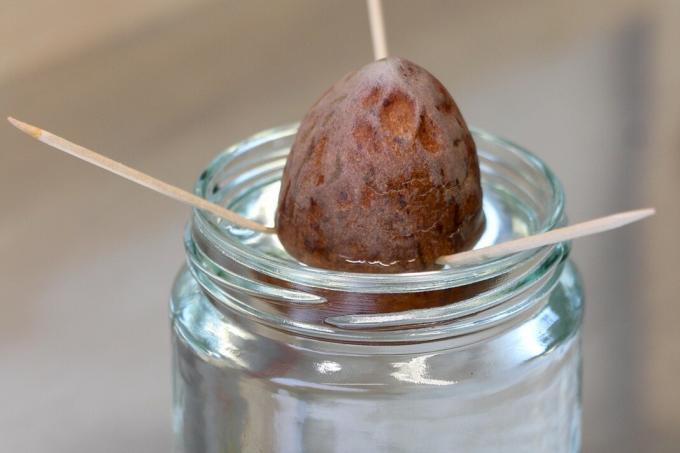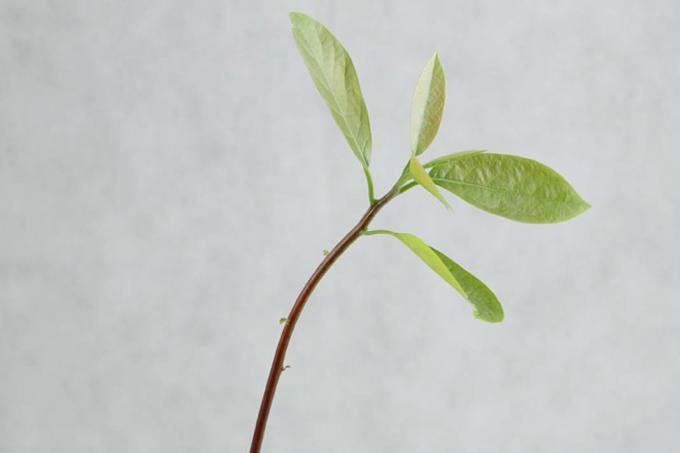
table of contents
- Origin & growth
- care
- Location
- Cultivation in a pot
- Cultivation in a water glass
- Growing in the greenhouse
- to water
- Fertilize
- Cut
- Diseases
Profile and care information open +conclude -
- Flower color
- yellow-green
- Location
- Sunny
- Growth habit
- upright
- height
- up to 15 m
- Soil type
- sandy, loamy
- Soil moisture
- moderately moist, fresh
- PH value
- neutral
- Limescale tolerance
- Calcium tolerant
- humus
- rich in humus
- Poisonous
- Yes
- Plant families
- Laurel family, Lauraceae
- Plant species
- Fruit trees, potted plants
- Garden style
- Pot garden, orchard
The avocado or Persea americana or Persea gratissima is one of the laurel family and is native to warm, rather dry areas. Avocados from the supermarket are often lacking in quality and they are also relatively expensive because they have usually traveled a long way. Growing your own avocado tree is well worth a try. In these planting instructions you will find helpful hints and tips for the cultivation and care of this exotic plant.
Origin & growth
The avocado tree reaches a height of up to 15 meters and is originally from southern Mexico. The fruit has been grown in tropical and subtropical Central America for 10,000 years. With the Spanish, the plant came to Chile, Madeira and the Caribbean. During the 19th In the mid-19th century, it also spread to Madagascar, Africa, the Philippines and Malaysia.

care
Since the beginning of the 20th Century the avocado is also planted in the Mediterranean area. In addition, more than 400 cultivars are grown in the tropics around the world. In addition, the fruit reached Israel, South Africa, Peru, Chile, California, New Zealand, Australia and southern Spain (coast of Granada and Malaga).
The avocado tree is an evergreen plant that grows quickly in warm, rather dry areas. The tree bears its first fruits after about four years. In order for the avocado tree to be pollinated, it needs two different tree species.
Growing avocado
Basically, the avocado tree reproduces through its avocado kernel, the seed. There are three different ways of making the core grow for propagation.
- Growing in the greenhouse
- Water glass toothpick method
- Cultivated by planting the kernel in moist soil

Location
The exotic avocado can also be cultivated in the Central European climate. If it is not grown outdoors, it will also grow in continental climates.
When choosing a location, you should consider:
- in summer the plant likes a sunny spot in the garden or a constantly warm place in the house or apartment
- Avocado plants also thrive in the greenhouse
- the avocado needs a light location
- Temperatures around 25 degrees are ideal
- the plant does not get the direct midday sun or blazing sunshine
- You should also protect your avocado plants from frost, because avocado trees are still quite sensitive in the first three years

Substrate
- the earth should be slightly damp, but not wet at all
- avoid waterlogging at all costs
- It is best to use normal potting soil, which has sufficient nutrients
- The avocado sprout should also be repotted once a year to stimulate its growth
- if brown leaves appear on the plant, this is often due to too much water
- the brown leaves must be removed immediately
Cultivation in a pot
Growing in a pot or bucket
The ideal time to plant the avocado is January and February. Growing an avocado indoors is not that difficult. To do this, you need a pot or bucket and an undamaged avocado seed. You can of course use an avocado from the supermarket here.

The core should be free of pulp and put with its thick end down into the moist soil. Its tip should look out at the top. If you plan to grow avocados yourself, it is important that you keep the soil in the pot moist on a regular basis. You need patience until the first offspring is visible. Allow a lot of time when growing avocados.

After four to eight weeks, the avocado kernel pops up and forms a sprout. This is initially quite unsightly and still looks very sparse. Don't be shy and cut ten to eight centimeters above the tip of the avocado seed. This creates more handsome branches that make the plant look bushier and fuller.
Cultivation in a water glass
The water glass toothpick method
With this cultivation method, too, use the kernel loosened from the pulp after consuming the avocado. Now put the core with its thick end down in a water glass. Then attach three toothpicks to the core. Be careful not to insert them too deeply, just enough to hold the toothpicks.

With this construction, the avocado core stands upright in the glass. The water glass must then be filled with the plant substrate and water to just below the tip of the core. It is recommended to wrap the glass with aluminum foil or paper from the side. It should remain open at the top.
So that the avocado kernel can germinate well, keep it in a warm and dark place. The temperature should be at least 20 degrees Celsius. Now you need patience again. After four to eight weeks, the first roots form and the shoot begins to grow. The water level must always be kept constant during this time.

If you discover the first roots and shoots of the seedling, place the container in a bright place. However, protect the seedling from direct sunlight. The roots must never be in the sun, so the glass should also remain wrapped.
Repot
When the root ball completely fills the glass, the time has come to add the avocado seeds or Repot the miniature avocado tree into a larger container. Use a nutrient-poor substrate for this. The soil should not be too acidic and should have a high proportion of sand.
For repotting you will need:
- a larger container, preferably a clay pot
- fresh substrate (peat mixture, palm or potting soil)
- spray bottle
- Nail or rose scissors
- for spraying the plant: room warm, stale water
When repotting, proceed as follows:
- take the avocado out of its pot
- grab them by the trunk as far as possible, as far down as possible
- remove the pot and old debris from the root ball
- the bale can now be placed in a new pot provided for this purpose
- fill the pot with fresh substrate
- remove the remains of the kernel, it is no longer needed for the supply of the plant
- the avocado must now be covered more deeply with soil in order to be able to develop new roots
- Finally, spray the soil and the leaves of the plant with water

Growing in the greenhouse
Avocado growing in the greenhouse
It is also possible to grow an avocado plant in a greenhouse without any problems. To do this, put the core in a flower pot as described above or use the water glass method. However, a prerequisite for growing the avocado in the greenhouse is a sunny, light location. The greenhouse should also be heated in the cold season. The avocado needs constant warm temperatures.
The harvest
Avocado trees that have been grown from seeds or cuttings only bear fruit after four to six years at the earliest. Rather, assume that you won't be able to harvest your first avocados for ten years. Given our climatic conditions, it is rather unlikely that the avocado tree will ever bear fruit.
The reason for this is that the avocado does not belong to the self-pollinators and the local warm periods are simply too short for the development of a fruit. However, the avocado tree itself is an attractive plant that is extremely popular with gardening enthusiasts, even if they cannot harvest any fruit.
to water
The avocado only needs a small amount of water. It does not tolerate waterlogging and should therefore only be watered a little. You can also let them dry out completely. When the leaves droop, water the plant again. On hot summer days, the avocado needs water every day, in winter it can be watered less often. The irrigation water is preferably stale and room temperature.
Fertilize
The avocado should be fertilized for the first time when it is between four and six months old. The young avocados still get their nutrients from the core, so the plant has to be used carefully to fertilizers. Fertilizer is best for citrus fruits or potted plants. You should start with a maximum of one third of the specified amount of concentrate. The amount of fertilizer should be increased slowly. Fertilization should be done every two weeks, fertilization is less frequent in winter.

Brown leaves are often caused by:
- too much water (check the roots for rot)
- too little water (the leaves are brown and crumble, especially at the tips)
- wrong substrate (there are avocado varieties that do not tolerate classic potting soil
- wrong fertilizer
- wrong amount of fertilizer (too much or too little)
- too small pot (if in doubt, you should always repot the plant)
Cut
If the avocado plant is left to its own devices and its growth is not interfered with, it will only develop a shoot. This shoots up and then usually kinks at some point. Most of the time, only a radical cut will help by removing the top of the plant.
After a few days you can already see new side shoots on the plant, which are now also growing upwards. These should also be cut after a certain period of time. Avocados tend to branch quite well when the tip has been stripped from them. Untrimmed avocado plants tend to be slow to grow.
Overwinter
Avocados are tough enough to stand outside until the first frost. Then it is high time to bring them into your apartment or house. If the temperature difference is too great, the plant will sprout too quickly. To prevent this, you should move the avocado plant indoors at mild temperatures. A bright location with a constant room temperature is ideal.
Water sparingly in winter. The earth may also become completely dry from time to time. Avocados are tropical plants and need a relatively high level of humidity. Dry heating air often causes the leaves to turn brown. To prevent this, the plant should be sprayed with lukewarm water every two to three days. In spring, when there are no more night frosts, the plant is allowed to go back outside. It will stay there again until autumn.
Diseases
The sturdy avocado tree is not particularly susceptible to disease. Nevertheless, it happens that the ideal breeding ground for pests is given in dry heating air or warm temperatures. The plants are then often attacked by spider mites or scale insects. To prevent these pests, you can regularly shower the plant with water.
Another disease that can occur in the avocado plant is root rot. This usually occurs due to excessive watering. Avocados do not tolerate waterlogging. Root rot is caused by hose fungus. These multiply mainly in damp environments and attack the roots.

The result is their slow death. If the plant suffers from root rot, it looks puny and stunted. The earth also smells unpleasantly musty and putrid. If you notice root rot on your avocado plant, you should remove the wet soil immediately and provide the plant with fresh, dry soil. This often leads to regeneration of the plant.
Pests
Avocados sometimes suffer from fungal diseases, but damage from insects or viral diseases is rather rare. A form of viral disease has been found in avocados, the so-called "sunspots". The rare virus can be spread through seeds and pollen, but not insects. There are many insects that damage plants and fruits, but these only occur locally to a greater extent. There is never as much damage to the plant as can be caused by fungi.
